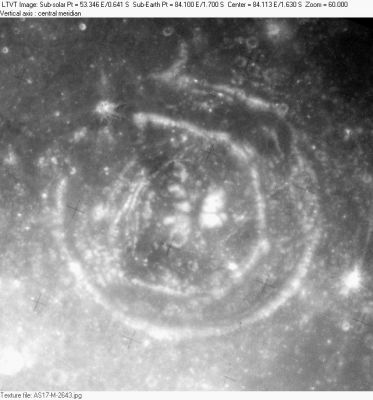Haldane
Contents
[hide]Haldane
|
Lat: 1.69°S, Long: 84.07°E, Diam: 40.26 km, Depth: 0.325 km, Rükl: 49 |

Images
LPOD Photo Gallery Lunar Orbiter Images Apollo Images
- AS17-148-22766 is Apollo 17's orbital close-up color Hasselblad of Haldane's western half. Check out the LPI's Print Resolution JPG of AS17-148-22766 too! (4.7 MB). Research: Danny Caes.
- AS17-139-21298 and AS17-139-21299 are Apollo 17's two orbital black-and-white Hasselblads of Haldane and its environs. Research: Danny Caes.
Maps
Description
Wikipedia
Additional Information
- IAU page: Haldane
- Depth data from Kurt Fisher database
- Pike, 1976: 0.325 km
- Westfall, 2000: 0.82 km
- Haldane is regarded as a flooded floor fractured crater of Class III (Schultz, 1976b). According to LTO-81B1, the central peaks and internal ring are as tall or taller than the main crater rim. Schultz attributes this effect in Haldane and other similar craters to an uplifting of the floor by an intrusion of subsurface volcanic material. He is less clear about what produced the ring in the first place. - Jim Mosher
Nomenclature
- Named for John Burdon Sanderson Haldane (November 5, 1892 - December 1, 1964), who normally used "J.B.S." as a first name. He was a British geneticist and evolutionary biologist, and one of the founders (along with Ronald Fisher and Sewall Wright) of population genetics.
- This name appears on LTO-81B1 (for which it served as the chart title). It does not appear to replace any previous IAU-approved designation. Although it appears in the cumulative list of approved names printed in IAU Transactions XVB, when and how it came to be approved is not entirely clear from the IAU record. Biographical information was unofficially reported in Ashbrook, 1974. - Jim Mosher
LPOD Articles
Bibliography
Named Featues -- Prev: Hainzel -- Next: Hale